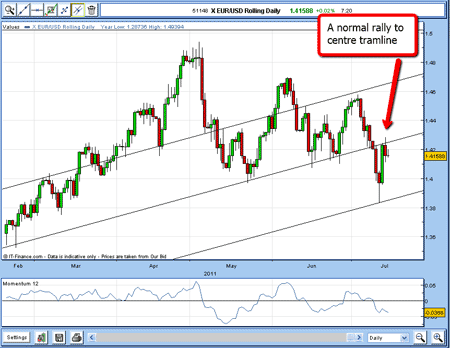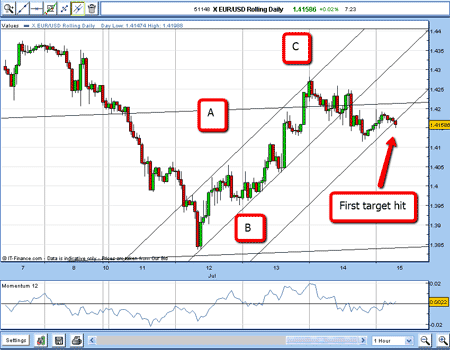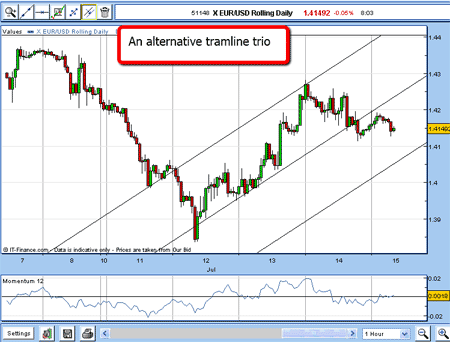More drama in the currency markets
The euro's recent rally corrected its hugely oversold condition. But which way would the market turn next? John C Burford looks at the charts to identify some likely trades.
As a trader, it is my job to try to anticipate the market using the methods that I have found work reliably over time.
But I cannot stress enough that there is no method or trading system on earth that can offer 100% success, or even close to it. Please don't waste your energy looking for one!
Trading is tough, and I only take positions where I feel the odds are on my side.
MoneyWeek
Subscribe to MoneyWeek today and get your first six magazine issues absolutely FREE

Sign up to Money Morning
Don't miss the latest investment and personal finances news, market analysis, plus money-saving tips with our free twice-daily newsletter
Don't miss the latest investment and personal finances news, market analysis, plus money-saving tips with our free twice-daily newsletter
But I always use protective stops, just in case I am wrong.
On Wednesday, I left the story after the euro had plunged 800 pips in a few days to the 1.38 area from 1.46. Recall, we caught that move: An exciting time to be trading the euro.
The market has been rallying to correct the hugely oversold condition and has rallied to my central tramline, where it has met heavy resistance:

Now let's get a close-up of this rally. The character of it should give me clues as to its duration and extent. Here is the latest hourly chart:

From Tuesday's low, I can draw a nice tramline trio and the rally sports a clear A-B-C pattern to boot.
When I see such a three-wave correction to the main trend (in this case, down), I do get excited, as it helps confirm my bearish view.
This is a textbook rally
If you are using my tramline methods, I will say that you need at least two points for a line.
Here, when the market made the second and third lows on Wednesday, I could then draw that tramline.
Then, when Tuesday's highs were in, I could draw my upper tramline.
From there, I could tentatively forecast that the market would rally close to the upper tramline at some point.
This duly occurred early Thursday morning at the 1.3280 level my wave C.
Odds were now high that this would mark the end of the corrective rally.
Traders could then have shorted the market, especially as momentum was very overbought.
Those positions could have been protected with fairly close stops, since a solid move above my tramline resistance would probably indicate a further resumption of the rally.
I would then have to search for another short trade probably using Fibonacci retracements as a guide.
Now with my first two tramlines, I could draw a third equidistant and parallel.
And the market is challenging this level as I write.
A possible alternative target for short-term traders
But just to confuse, there are alternative tramline set-ups that I can find!
Here, I have drawn the upper two lines across significant highs and lows, and they appear valid.

The lowest tramline will now be a possible target for short-term traders to be taking profits.
But, interestingly, the price targets given by my two tramline set-ups are almost identical!
And as I finish this piece, the market has fallen and is within pips of hitting it.
There is so much going on in my markets of EUR/USD, Dow, and gold. I will not run short of topics to write about fear not. I have a sense that some very big moves are up ahead.
Don't miss my next trading insight. To receive all my spread betting blog posts by email, as soon as I've written them, just sign up here .
Get the latest financial news, insights and expert analysis from our award-winning MoneyWeek team, to help you understand what really matters when it comes to your finances.
John is is a British-born lapsed PhD physicist, who previously worked for Nasa on the Mars exploration team. He is a former commodity trading advisor with the US Commodities Futures Trading Commission, and worked in a boutique futures house in California in the 1980s.
He was a partner in one of the first futures newsletter advisory services, based in Washington DC, specialising in pork bellies and currencies. John is primarily a chart-reading trader, having cut his trading teeth in the days before PCs.
As well as his work in the financial world, he has launched, run and sold several 'real' businesses producing 'real' products.
-
 The shape of yields to come
The shape of yields to comeCentral banks are likely to buy up short-term bonds to keep debt costs down for governments
-
 The sad decline of investment clubs – and what comes next
The sad decline of investment clubs – and what comes nextOpinion Financial regulation and rising costs are killing off investment clubs that once used to be an enjoyable hobby, says David Prosser